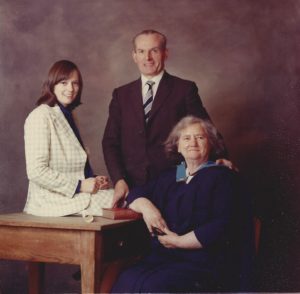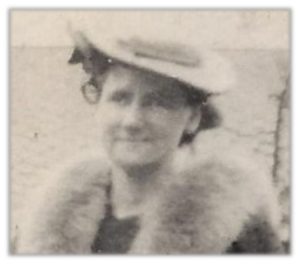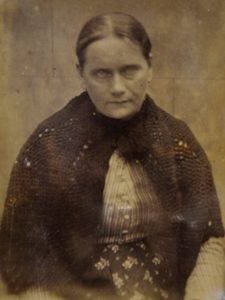calsfoundation@cals.org
“Hunting the Skeleton”: Guest post by Butler Center Books author Bernadette Cahill
“Your responsibility is not to judge what you find. You are just to record the history,” genealogist Earnest E. Lacey said at the CALS Genealogy Workshop in Little Rock in 2011.

This statement makes good sense to me: if I hear a skeleton rattling in a closet, I will let it out as fast as I can. I want to know what it is. But Lacey’s words returned to haunt me as I reached an apparent conclusion for the family history I was already embarked on, for I found others sometimes preferring to bar the door as they resisted uncovering “unacceptable” family history.
My project already had special problems. It began with hunting for more information on a story my mother told me in 1968—the fiftieth anniversary of the Votes for Women victory in Britain—and running right into the Clydebank Blitz. No family lore indicated that once I had dug through that rubble, there would be more disturbing things to uncover.
Mum’s story was about helping to campaign for women’s voting rights when a student at Glasgow University.
The Clydebank Blitz of March 1941 killed and injured hundreds and destroyed the densely populated town where 50,000-plus souls had lived. Clydebank proportionately lost more lives than all other British blitzed towns and was the only one evacuated. Those who lived through the onslaught experienced immense psychological damage, which affected later children. Bombs that demolished homes also destroyed family memorabilia wholesale—photos, documents, letters, and other personalia.
Mum, her parents, and siblings all survived in shelters or the hills; but the home did not survive, and no usual historical sources survived from before March 13, 1941. There is nothing to show what Mum looked like as a girl; nothing of her with her mum, dad, or siblings; nothing documenting the achievements of her early life. No souvenirs from her summer job with details about what she called the Clyde Coast Campaign. This meant that I needed to find alternative sources, some examples of which CALS’s Alysanne Crymes’s recent blog about offline sources outlined.
To start, I had a recording of Mum telling me about the campaign, which I had made during a quick trip home from Canada in 1984, when she was in her seventies and I was aware that time was running out.
Mum told how she had worked with a Lilian Lenton in Rothesay, on the Isle of Bute in the River Clyde, Scotland, and how Dr. Frances Melville, mistress of Queen Margaret College, had arranged the job for her; how she was taught to attract listeners from the holiday crowds by standing high on a tea chest and calling, “We are here today under the auspices of the Women’s Freedom League”; how “Madam Lenton,” as Mum called her, taught her ways to deal with hecklers; and how wonderful the food was.
But there were no dates. As Mum said on tape, by 1984 there was a lot she could not remember, adding wistfully, “No one nowadays knows anything about the Clyde Coast Campaign.”
There was, however, information in secondary sources about the women Mum named. They linked me to both militant wings of British suffragism: the violent Women’s Social and Political Union and the nonviolent Women’s Freedom League. Born in 1891, Lenton had originally joined the WSPU when she turned twenty-one, vowing to burn down a building a week till women won the vote. Later she worked for the Scottish hospitals in Serbia and when the WSPU disbanded on victory, she joined the WFL, the 1907 breakaway from the WSPU.
Mum also linked me to the earlier suffrage law struggles, for Dr. Melville was one of the protagonists of a famous Scottish case, fought to the House of Lords in 1908 for women graduates’ right to vote. Melville’s role as an educator also linked me to the education for women movement that had helped to build the case for women’s vote.
I filled much of this in from wide-ranging research started by Mum’s tape. My sister, Dr. Catherine Smith, later added many details from memories of talks with her, establishing that Mum, when she was a student at Glasgow from 1927, worked for equality in the vote during the last ten years of the campaign after the principle of Votes for Women was won in Britain in 1918. She probably assisted before becoming a student.
When Ron Davis, my American Southerner husband, digitized the tape on Mother’s Day 2006 and I heard Mum’s voice for the first time in more than twenty years it was emotional. But the recording raised many questions—such as when exactly did she attend Glasgow University? When did she graduate?
Meanwhile, Catherine’s husband, Cairns Mason, was researching family genealogy and had struck a blank with Mum’s dad in 1905. Perhaps he had only just arrived in Scotland, for he appeared in no earlier records. We knew, however, that Grandpa and sons were riveters in John Brown’s Shipyard, working on Cunard’s Queen Mary and Queen Elizabeth.
Then in late January 2007, on a sudden trip home, I headed to Glasgow University Archives to hunt facts about Mum, and of my dad, Thomas Peter Cahill (M.A. 1952). I also hoped to find information about my grandfather and uncles, for I had discovered that GU Archives held John Brown’s Shipyard archives.

Even though I was dropping in with no appointment, the archivists nevertheless opened their doors for me and soon they had found and copied the student records for Mum and Dad—a treasure trove with dates and addresses new to me. They were powerful, for just seeing the written name of someone you love and has long gone somehow brings a lump to the throat. One of the most emotional finds was Dad’s writing and signature on a letter applying for entry to Glasgow University in 1948. I determined that, as Margaret McCann, my mum graduated M.A. in 1931 and taught math.
The treasures in John Brown’s archives that the archivists dug up were the apprenticeship papers of my grandfather, William McCann, and those of Uncles Willie and Jim. The most important fact to emerge was that Grandpa signed on in John Brown’s in 1900, which pointed to his immigration from Ireland earlier than 1905. This data led my brother-in-law to the 1899 death certificate of my great-grandmother—and the point where the quiet rattle of a skeleton began reaching my ears. The certificate revealed something very unsettling: she had died in Stirling District Asylum at Larbert, a mental hospital.
The matter largely rested there from 2007, but in 2012, while in Little Rock researching my first suffrage book, Alice Paul, The National Woman’s Party and the Vote: The First Civil Rights Struggle of the 20th Century, a huge breakthrough came: the internet turned up the WFL newspaper through a news item on Alice Paul. Soon, from that, I had documentary confirmation of Mum’s tale and much further information about the forgotten Clyde Coast Campaign, which seems to have been the longest-running campaign for the vote and equal rights anywhere in Britain in the 1900s.
Then the 2018 centenary of partial victory in Votes for Women approached, and I planned trips to Britain for presentations in Rothesay, Stirling, Clydebank and Cambridge about Mum’s tale. Meanwhile, a cousin found on Ancestry.com documents showing that my great-grandmother gave birth to my grandfather out of wedlock.
Under what circumstances Rose Ann Quinn got pregnant and by whom remains a mystery. But this information led me back one sleepless night to her death certificate. “What is that?” I demanded of the cause of death and jumped onto the web to find out.
“General paralysis of the insane,” I discovered, was usually linked to syphilis. The skeleton rattled louder in the dark of the night. I began to shake. Unsettling questions rose unbidden in my mind. How did she get syphilis? From whom? Was she raped—by a Lord of the Manor where she might have worked? A violent assault? Was she a prostitute to keep body and soul together in poor, rural Ireland? Would we ever know? Would we want to?
But we could get some information: for, stunningly, while hunting the skeleton, I next found that the records from Stirling District Asylum, which closed many years ago, were located in the archives in Stirling University, a town where I would be speaking in a month’s time.

A few emails later, I had a typescript of my great-grandmother’s records and an appointment to see and photograph the originals. On February 9, 2018, the duty archivist welcomed Ron and me, leading us to a table with five huge volumes on it, each marked at relevant places. He opened the first one in front of us. And there, on the first page, staring up at me was my great-grandmother. My husband gasped. I began to cry.
This 1895 photo was pure gold. So was the rest of the record, whose extent was unusual for one individual—a measure of how serious her condition was. As I was examining it, I found the great-grandchild in me asking, “Granny, why did you have to go through all this hell?” But the historian exclaimed, “Granny, thank you for leaving this trail for me to find.”
Lacey’s warning about not judging what you uncover now proved important, for some family members were resistant and horrified about our great-grandmother’s circumstances and could not join in our elation about our great finds. Others were over the moon about the photograph. The medical notes fascinated friends in the medical field.
The further implications of these discoveries took some time to sink in. One was that we now had a photograph of a family member from before that awful night of March 13, 1941, when the Luftwaffe destroyed the McCann family’s home and everything in it. The second was that my great-grandmother’s sad circumstances gave me a direct link to another women’s-rights issue—which nineteenth-century women delicately called “the sexual double standard.” It was about venereal disease, brought home to many a wife by her husband.
Perhaps marriage is how Great-Grandma Quinn became infected: another cousin later found she also had an out-of-wedlock daughter, married a William McCann, took his name and gave it to her son, William. This raised more questions. Was this man the father of both her children? Was the father of William someone else? Does the McCann name correctly belong in our lineage? How many unknown relatives do we have? The list of so far unanswerable questions is extensive. And this is where the story stands, awaiting a DNA hunt.
The research I began because of my mother’s 1968 story produced a trail of historical articles and presentations about the Clyde Coast Campaign. On Victory Day—February 6, 2018—in Rothesay, where Mum had worked, a huge crowd learned of a story no current locals had heard before.
Librarians, both general and specialized, and archivists, both in the U.K. and the United States, including the U.K. Parliament and the Library of Congress, have given me considerable research help for my history research. One stunning experience was the work the Radcliffe Institute of Harvard did, despite a major upheaval in their workplace in summer 2018, to access a letter about Susan B. Anthony—a key document, proving she was not responsible for something she was accused of in 1867. It led to considerable re-writing of my 2019 book, No Vote for Women: The Denial of Suffrage in Reconstruction America, which I began in Little Rock. That same summer, Alysanne Crymes of CALS enabled me to research microfilms of a newspaper I could not otherwise access, allowing me to check a key source.
At the start, I never knew where I would end up in my history projects, but the information uncovered from offline sources with archivists’ and librarians’ assistance has been crucial, partially filling a huge blank in my own family’s history. They have also helped to heal a forgotten aspect of the long-term damage wrought by war. And some skeletons, previously unknown and now out of the closet, have been recorded and laid to rest.
***
Bernadette Cahill’s article “The Clyde Coast Campaign and Votes for Women in Rothesay 1909–1933” appears in the 2020 edition of the Transactions of Bute Museum and Natural History Society, Volume 30, pp. 8–17. Cahill is author of Arkansas Women and the Right to Vote: The Little Rock Campaigns, 1868–1920 (Butler Center Books, 2015) and two other books about votes for women. She and her three siblings appear to be the last living children of a British suffragette. She lives in historic Vicksburg, Mississippi.
Click here for more information on visiting the CALS Roberts Library.
And click here for more information on the upcoming genealogy workshop on July 24.




